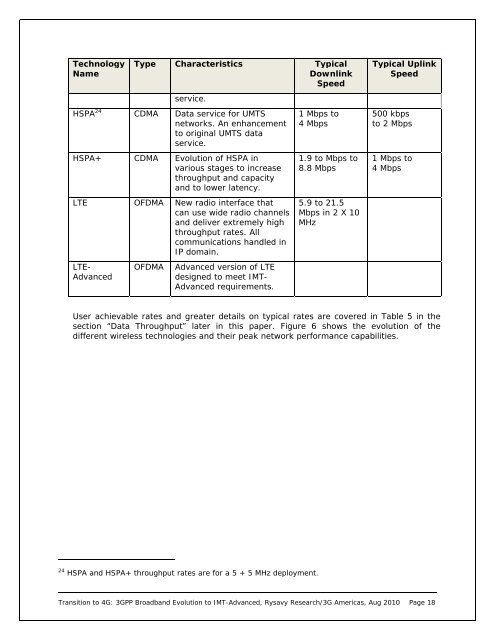3GPP Broadband Evolution to IMT-Advanced - 4G Americas
3GPP Broadband Evolution to IMT-Advanced - 4G Americas
3GPP Broadband Evolution to IMT-Advanced - 4G Americas
- No tags were found...
Create successful ePaper yourself
Turn your PDF publications into a flip-book with our unique Google optimized e-Paper software.
TechnologyNameType Characteristics TypicalDownlinkSpeedservice.HSPA 24 CDMA Data service for UMTSnetworks. An enhancement<strong>to</strong> original UMTS dataservice.HSPA+ CDMA <strong>Evolution</strong> of HSPA invarious stages <strong>to</strong> increasethroughput and capacityand <strong>to</strong> lower latency.LTE OFDMA New radio interface thatcan use wide radio channelsand deliver extremely highthroughput rates. Allcommunications handled inIP domain.LTE-<strong>Advanced</strong>OFDMA<strong>Advanced</strong> version of LTEdesigned <strong>to</strong> meet <strong>IMT</strong>-<strong>Advanced</strong> requirements.1 Mbps <strong>to</strong>4 Mbps1.9 <strong>to</strong> Mbps <strong>to</strong>8.8 Mbps5.9 <strong>to</strong> 21.5Mbps in 2 X 10MHzTypical UplinkSpeed500 kbps<strong>to</strong> 2 Mbps1 Mbps <strong>to</strong>4 MbpsUser achievable rates and greater details on typical rates are covered in Table 5 in thesection “Data Throughput” later in this paper. Figure 6 shows the evolution of thedifferent wireless technologies and their peak network performance capabilities.24 HSPA and HSPA+ throughput rates are for a 5 + 5 MHz deployment.Transition <strong>to</strong> <strong>4G</strong>: <strong>3GPP</strong> <strong>Broadband</strong> <strong>Evolution</strong> <strong>to</strong> <strong>IMT</strong>-<strong>Advanced</strong>, Rysavy Research/3G <strong>Americas</strong>, Aug 2010 Page 18
















